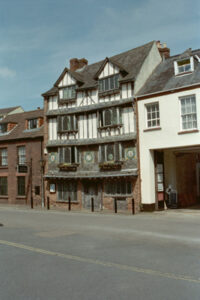27 May 2021
Unintended Consequences
Mortgage Lenders, Listed Buildings and EPCs
by Lynda Goetz
 Laudable or laughable? The government’s proposed plans for making mortgage lenders consider the energy efficiency ratings of properties on which they lend sounds initially like a Good Thing, surely? Well, yes, except, as so often in such matters, for the ‘Law of Unintended Consequences’. Plans under consideration could require mortgage lenders to attain Higher Energy Performance Certificate (EPC) ratings across their portfolios by as early as 2025. Under plans being considered, homes could be expected to achieve a rating of C or above by 2030. As yet another measure being looked at to help with the issue of climate change, this, at first sight, looks welcome. There would, of course, be costs involved for those whose properties do not comply with the higher standards; however, grants could perhaps help those who need to replace boilers, add insulation or install double glazed windows. Apart from the onerous burden which could be placed on those who need or want to sell, but whose properties do not comply, what about all those owners of Listed Properties? Nowhere so far have I seen this mentioned.
Laudable or laughable? The government’s proposed plans for making mortgage lenders consider the energy efficiency ratings of properties on which they lend sounds initially like a Good Thing, surely? Well, yes, except, as so often in such matters, for the ‘Law of Unintended Consequences’. Plans under consideration could require mortgage lenders to attain Higher Energy Performance Certificate (EPC) ratings across their portfolios by as early as 2025. Under plans being considered, homes could be expected to achieve a rating of C or above by 2030. As yet another measure being looked at to help with the issue of climate change, this, at first sight, looks welcome. There would, of course, be costs involved for those whose properties do not comply with the higher standards; however, grants could perhaps help those who need to replace boilers, add insulation or install double glazed windows. Apart from the onerous burden which could be placed on those who need or want to sell, but whose properties do not comply, what about all those owners of Listed Properties? Nowhere so far have I seen this mentioned.
For those who have never owned or even considered this particular class of property, a brief explanation may be helpful. Listed Properties are either Grade I or Grade II listed. Both are considered to be of historic interest and importance, but the former are subject to even more stringent regulations. Historic England controls listing in England (there are separate bodies in Scotland Wales and Northern Ireland) and, according to their website, only 2.5% of listed buildings are Grade I listed. It is estimated that there are a total of around half a million buildings on the National Heritage List for England (NHLE) site (estimated because some listings cover a number of individual units). Over 58,000 of these are in Devon, which appears to have been particularly assiduous in categorising its buildings. Of course, it is wonderful that historic buildings cannot, in this country, simply be altered, changed and rebuilt without taking account of their architectural and historical merit and significance. Nevertheless, there are some bizarre and not particularly logical rules which apply to these 500,000 odd buildings.
 One of the more common planning rules applied to listed homes is the prohibition against having double or triple-glazed windows. Even though so many of these nowadays look indistinguishable from their single-glazed counterparts, it is very normal for their inclusion to be banned from any updating works which a house owner may be undertaking. This is of course highly likely to keep their EPC rating below the soon-to-be-required C. Likewise, any solar-panelling company, hassling for business, will put the phone down once they are told a house is listed. Putting solar panels on the roof of a listed building is difficult, if not impossible, in spite of the fact that generally, such actions are being encouraged. And so it goes on. It is important and necessary to move forward; to make legislative changes which will encourage much greater energy conservation; at the same time we are hampered by conflicting, anachronistic and often pointless regulations which apply to our historic housing stock.
One of the more common planning rules applied to listed homes is the prohibition against having double or triple-glazed windows. Even though so many of these nowadays look indistinguishable from their single-glazed counterparts, it is very normal for their inclusion to be banned from any updating works which a house owner may be undertaking. This is of course highly likely to keep their EPC rating below the soon-to-be-required C. Likewise, any solar-panelling company, hassling for business, will put the phone down once they are told a house is listed. Putting solar panels on the roof of a listed building is difficult, if not impossible, in spite of the fact that generally, such actions are being encouraged. And so it goes on. It is important and necessary to move forward; to make legislative changes which will encourage much greater energy conservation; at the same time we are hampered by conflicting, anachronistic and often pointless regulations which apply to our historic housing stock.
The new legislation currently under consideration is going to positively discriminate against all those who have purchased and own historic housing, particularly where it is listed. Many of these are not grand, nor are their owners wealthy. Modern houses can easily be built to be much more energy efficient. It is usually costly to make old housing stock comply with modern standards. However, where it is literally prohibited to do so, what happens then? Those currently doing their best to look after and conserve homes which are of historic interest are already penalised by much more onerous planning regulations any time they wish to update or make alterations. The legislation proposed is not only going to make the ownership of such properties even more burdensome than it already is, but, unless allowance is made to ensure that these buildings, without destroying their intrinsic fabric and nature, can be adapted to the needs of the 21st and beyond they will simply become even more of a liability than they are currently. Those owning them will attempt to sell, probably unsuccessfully and only those not needing a mortgage and altruistically wishing to throw money at them will ever be able to own them. Is this really what we need or want? If plans are afoot to ensure that mortgage lenders require higher EPC ratings, then alongside that it will also be necessary to amend our anachronistic Listed Buildings regulations.


